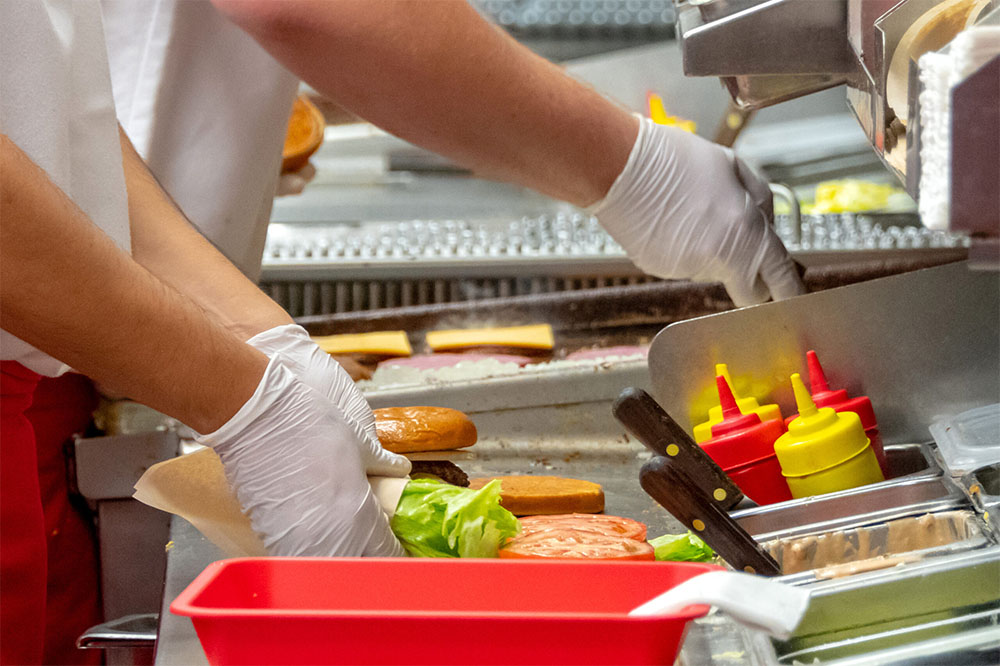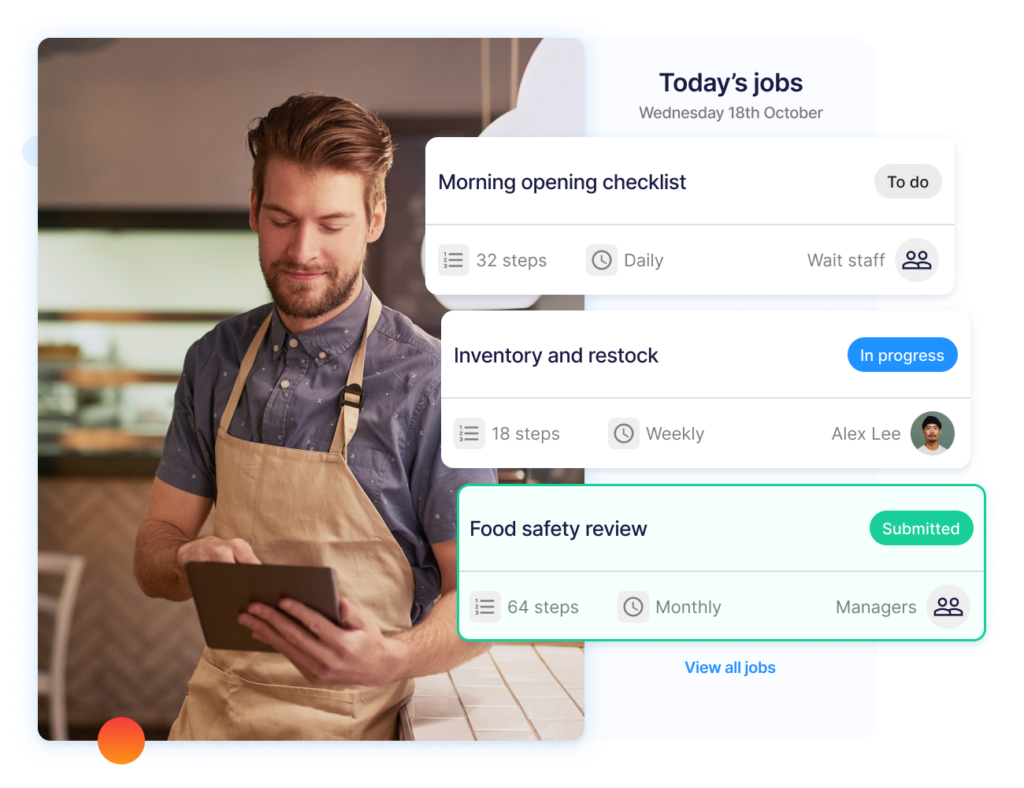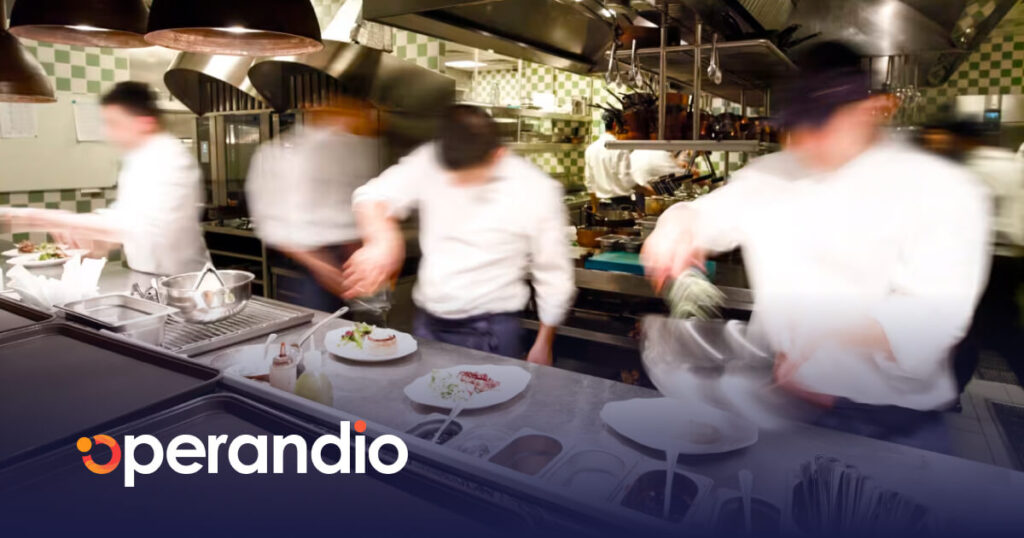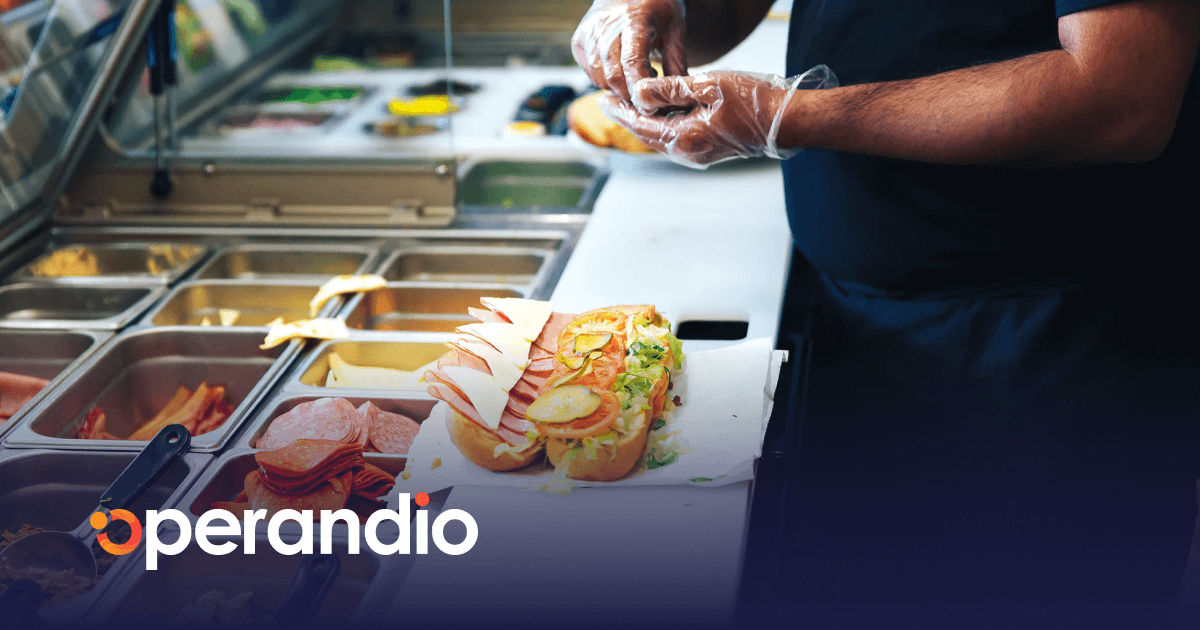Operandio is your more-in-one food safety and compliance software that frees you up to focus on what really matters – delivering great food and service. Book a demo to get your custom pricing.
Food safety compliance: what it is, best practices, tools & more
Most restaurant owners think they’ve got food safety culture covered – right up until that clipboard shows up unannounced.
Suddenly, every missed checklist item feels like a spotlight on your operation. One small oversight, like a mislabeled ingredient or missed cleaning step, can lead to fines, complaints, or worse. Understanding how to label food correctly is crucial to avoiding such risks and ensuring compliance with safety regulations.
Between shifting regulations and constant pressure to maintain standards, food safety compliance can feel like you’re chasing your own tail. But it really doesn’t have to.
This guide breaks down everything you need to know to stay inspection-ready, avoid costly mistakes, and protect your brand.
Food compliance: Key takeaways

- Food safety compliance protects your brand and your customers. It’s about following strict rules to avoid contamination, prevent illness, and meet legal standards.
- Non-compliance can be costly. Fines, negative publicity, and even business closures can result from failing to meet food safety regulations.
- You don’t have to navigate it alone. With tools like Operandio, you can simplify compliance, track key processes, and keep your team audit-ready.
- Consistency is key. From proper hygiene to regular inspections, following clear procedures, such as a detailed kitchen inspection checklist, ensures every shift runs smoothly
What is food safety compliance?

Food safety compliance is about following the rules, regulations, and industry standards that ensure the food you serve is safe to eat.
These regulations are set by authorities like the Food and Drug Administration (FDA) and local health departments. They require you to follow strict procedures at every stage of your operation. From ingredient traceability to hygiene protocols, every process must be accounted for and documented.
It’s more than just avoiding fines—it’s about protecting your customers from health risks like foodborne illnesses, contamination, and allergen exposure.
At the heart of food safety compliance is a food safety plan. This plan outlines the specific steps your business takes to identify, prevent, and respond to potential hazards. It includes everything from food storage and preparation to cleaning protocols and employee hygiene. A strong safety plan ensures your entire team knows exactly what to do to maintain compliance every day—not just when an inspector shows up.
Food safety compliance: 5 key steps to improve food safety and protect your brand

Achieving food safety compliance doesn’t have to be overwhelming. You can create a safer, more consistent operation by focusing on a few key steps:
1. Conduct a Thorough Hazard Analysis
- Why it matters: Hazards like contamination can happen anywhere in your operation. Identifying where they’re most likely to occur allows you to prevent issues before they happen.
- What to do: Pinpoint critical control points (CCPs) where contamination is most likely—like food prep areas or storage zones.
- Operandio Advantage: Use Operandio to document and track CCPs across all your locations, making sure every step in your HACCP plan is followed consistently.
2. Develop Clear and Comprehensive SOPs
- Why it matters: Without clear procedures, employees might “guess” their way through tasks, leading to inconsistency and errors.
- What to do: Write detailed Standard Operating Procedures (SOPs) for essential processes like food storage, cleaning, and hygiene.
- Operandio Advantage: Operandio makes creating, updating, and distributing digital SOPs easy so your team always has the most up-to-date guidance.
3. Train Your Team Continuously
- Why it matters: unfortunately, training isn’t a “set it and forget it” job! Regulations change, and employees come and go. Ongoing training keeps your team prepared.
- What to do: Schedule regular training sessions to cover everything from kitchen hygiene standards to new compliance rules.
- Operandio Advantage: Operandio tracks completed training and schedules reminders for re-certification so your team complies with training requirements tied to food safety certificate compliance.
4. Monitor Compliance in Real Time
- Why it matters: It’s one thing to set rules—it’s another to ensure they’re followed. Real-time oversight keeps your team accountable.
- What to do: Conduct regular inspections and audits to check for gaps in compliance.
- Operandio Advantage: Operandio’s digital checklists let you track inspections, flag issues immediately, and take corrective action fast.
5. Embrace Technology for Consistency
- Why it matters: Technology centralizes your operations, making it easier to keep consistency across every shift and location.
- What to do: Use a platform that allows you to manage compliance, inspections, and training in one place. Tools like a food safety app can streamline these tasks, reducing human error and improving accountability.
- Operandio Advantage: Operandio centralizes all your compliance tasks, letting you spot issues in real time and resolve them before they become serious problems.
Food safety compliance: 6 best practices & tips
Keeping up with food safety rules isn’t exactly the most exciting part of running a restaurant—but it is one of the most important. A missed step here or a forgotten check there can lead to big headaches (and even bigger fines).
Here’s how to stay ahead of it all, keeping your brand— and your sanity —intact.
1. Establish a Culture of Food Safety
- Why it matters: Compliance isn’t a one-time task—it’s a mindset that needs to be embraced by every employee, from kitchen staff to management.
- What to do: Make food safety a priority at every level of your organization. Reinforce it in team meetings, shift briefings, and onboarding sessions.
- Operandio Advantage: Use Operandio’s food safety software to communicate food safety goals to your team and ensure accountability with clear, trackable digital task assignments.
2. Set Up Regular Audits and Inspections
- Why it matters: Problems often go unnoticed until it’s too late. Proactive inspections catch small issues before they become big risks.
- What to do: Conduct routine checks to catch potential compliance issues early. Audit everything from food storage to hygiene practices.
- Operandio Advantage: Operandio automates inspection schedules, keeps records of completed audits, and provides instant feedback, so you’re always inspection-ready.
3. Maintain Accurate Records
- Why it matters: In a compliance audit, clear, accurate records are your best defense. If you can’t prove you followed protocol, you risk penalties.
- What to do: Document every step, from supplier checks to cleaning logs and equipment maintenance.
- Operandio Advantage: Store all records digitally with Operandio, so you can access them instantly during inspections—no more hunting through paper files.
4. Standardize Cleaning and Sanitation Procedures
- Why it matters: Inconsistent cleaning leads to contamination risks. Everyone on your team should follow the same process for cleaning and sanitation.
- What to do: Develop clear SOPs (Standard Operating Procedures) for cleaning and sanitation and ensure every shift follows them.
- Operandio Advantage: Distribute cleaning SOPs through Operandio, complete with checklists that staff can tick off as they go. No guessing, no shortcuts.
5. Engage and Train Employees Regularly
- Why it matters: Staff turnover happens, and food safety regulations change. Without ongoing training, knowledge gaps can form, leading to compliance failures.
- What to do: Schedule training sessions to keep employees up to date on best practices and new regulations. Emphasize that everyone plays a role in food safety.
- Operandio Advantage: Operandio makes it easy to schedule, track, and manage training sessions, so every team member stays in the know.
6. Monitor Supply Chain Compliance
- Why it matters: Your suppliers play a big role in food safety. If their processes fail, it impacts your business too.
- What to do: Work with suppliers who meet food safety standards and verify certifications regularly.
- Operandio Advantage: Use Operandio to track supplier certifications and flag issues when sourcing ingredients, so you’re always working with trusted partners.
Operandio: The food compliance software your restaurant needs

Operandio’s restaurant management software makes food safety monitoring simpler, faster, and more effective. Instead of relying on paper checklists and manual tracking, you get one powerful platform to manage it all.
- Digital SOPs — Say goodbye to outdated paper manuals. With Operandio, every procedure is stored digitally, always up to date, and accessible to your team at any time.
- Food labeling support — Operandio helps you manage critical food labeling tasks, for tracking allergens, expiration dates, and ingredient transparency.
- Real-time tracking — Know what’s happening in every location at every moment. Use digital checklists and task tracking to spot issues as they happen—not after.
- Automated inspections — Schedule audits and get real-time alerts if something’s missed, so you never fail an inspection again.
- Employee training — Keep your team sharp with ongoing training modules and track progress with completion reports.
- Centralized record-keeping — All your cleaning logs, inspection results, and training records are stored in one place, ready for any audit or inspection.
With Operandio’s digital food safety software, you don’t just “stay compliant”—you build a safer, more efficient operation where compliance is a natural part of your daily routine. No more scrambling for records or rushing to fix last-minute issues.
Discover more insights on best food compliance software in our in-depth guide
FAQs
1. What are the 7 FSMA rules?
The seven FSMA (Food Safety Modernization Act) rules aim to shift food safety from a reactive approach to a proactive one. They include:
- Preventive Controls for Human Food — Focuses on identifying and controlling potential hazards during food production.
- Preventive Controls for Animal Food — Applies similar rules to animal food production.
- Produce Safety Rule — Sets standards for growing, harvesting, and handling fresh produce.
- Foreign Supplier Verification Program (FSVP) — Ensures imported food meets U.S. safety standards.
- Accredited Third-Party Certification — Certifies third-party auditors for food safety compliance.
- Sanitary Transportation of Human and Animal Food — Regulates the safe transportation of food.
- Intentional Adulteration Rule — Focuses on preventing intentional contamination (like sabotage) in food production.
2. What are the golden rules of kitchen hygiene?
The golden rules of kitchen hygiene are the essential habits every food handler should follow to maintain safety and cleanliness.
- Clean as you go
- Separate raw and cooked foods
- Cook food thoroughly
- Keep cold food cold and hot food hot
- Practice personal hygiene
Final thoughts
Food safety compliance isn’t just a legal requirement—it’s a commitment to your customers’ health and your brand’s reputation. Every step you take to prevent contamination and maintain consistency builds trust.
Staying compliant doesn’t have to be a daily struggle. With tools like Operandio and clear best practices, you can turn compliance into a seamless part of daily operations—not a last-minute scramble.

Ready to simplify food safety management and stay audit-ready? Book your free demo of Operandio today and give the health inspector their easiest visit of the week.


